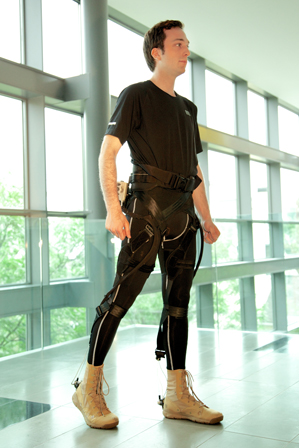A soft, lightweight exoskeleton developed at Harvard applies assistive force without interfering with a person’s normal gait.

A soft exoskeleton being developed by researchers at Harvard could let soldiers carry heavy backpacks over long distances or help stroke victims walk more steadily. The device, which helps propel the wearer’s legs forward, is extremely lightweight and efficient, and the researchers behind it were recently awarded a $2.9 million grant from DARPA to make the next version.
Exoskeletons augment the power of human limbs, allowing the wearer to carry heavier objects or walk for longer. Several impressive prototypes have been developed, but the big challenge is the amount of energy the devices use.
The Harvard prototype is much sleeker than most exoskeletons. It looks like a climbing safety harness made of nylon mesh and spandex, combined with cables that snake down the wearer’s legs.
Unlike some other exoskeletons, it could not help paralyzed people walk (see “Stand Alone). But people with muscle weakness, such as those who have suffered strokes, could use it to walk more easily, and it could help healthy people carry large loads farther.
Rigid exoskeletons often use hydraulics and motors to bear a person’s weight and make lifting easier (see “Iron Man-Like Skeleton Nears Production). More passive designs transfer the weight of a backpack to the ground, but this can cause an unnatural gait (see “MIT Exoskeleton Bears the Load).
The Harvard exoskeleton is highly efficient because it applies force in a way that closely aligns with the natural movements of muscles and tendons. Sensors monitor the wearer’s motion, and battery-powered motors move cables to pull up on the heel, or on part of the leg near the hip—adding a propelling tug at just the right moment as the wearer steps forward. “It’s quite lightweight, flexible, and conformal, says Conor Walsh, a professor of mechanical and biomedical engineering at Harvard. “It doesn’t disrupt normal walking and movement.
The machine is designed to fit easily under clothes, and novel, soft sensors made of silicone rubber are integrated into the suit. The sensors, developed at another lab at Harvard, include embedded channels filled with a conductive liquid that changes in resistivity as the silicone is stretched.
To make the device even more efficient, Walsh is studying human biomechanics and testing people’s energy consumption as they use it.
He is also hoping for advances in batteries to help lighten the load further. Whereas a person can walk 3.5 miles using the energy in a single cookie, an electric bike requires a battery weighing 10 times as much to travel the same distance. “Energy storage is still a challenge, he says.





